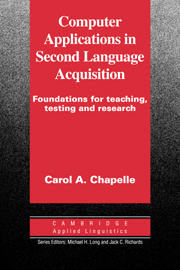Book contents
- Frontmatter
- Contents
- Series editors' preface
- Thanks
- Abbreviations
- 1 Historical foundations of CASLA
- 2 The context and challenge for CASLA
- 3 Computer-assisted language learning
- 4 Computer-assisted language testing
- 5 Computer-assisted SLA research
- 6 Directions for CASLA
- References
- Author index
- Subject index
3 - Computer-assisted language learning
Published online by Cambridge University Press: 05 October 2012
- Frontmatter
- Contents
- Series editors' preface
- Thanks
- Abbreviations
- 1 Historical foundations of CASLA
- 2 The context and challenge for CASLA
- 3 Computer-assisted language learning
- 4 Computer-assisted language testing
- 5 Computer-assisted SLA research
- 6 Directions for CASLA
- References
- Author index
- Subject index
Summary
One critic of research on computer-assisted learning described the reason for the lack of substantive progress in educational technology as follows:
Part of the difficulty, in my view, is that we tend to encourage students (and faculty) to begin with educational and instructional solutions and search for problems that can be solved by those solutions. Thus we begin with an enthusiasm for some medium … and search for a sufficient and visible context in which to establish evidence for our solution … If we begin by implicitly and explicitly attempting to validate a belief about the solutions to largely unexamined problems, we are less open to evidence that our intuitions might be very far off the mark.
(R. E. Clark, 1994: 28; emphasis in original)This situation, which may characterize CALL as well as it does computer-assisted learning in other areas, presents a problem for developing methodologies for CALL evaluation. It continues to prompt some to conceptualize the evaluation of CALL from the perspective of gross comparisons between computer-using learners with those learning through other media (e.g., Adair-Hauck, Willingham-McLain, & Yongs, 2000; Nutta, 1998), an approach unlikely to shed light on the problem or solution. Moreover, as researchers such as Pedersen (1987) pointed out, comparisons of CALL versus classroom learning outcomes create an irony wherein the most precise and sophisticated modern tool is investigated through the most crude and outdated educational research methods.
- Type
- Chapter
- Information
- Computer Applications in Second Language Acquisition , pp. 44 - 94Publisher: Cambridge University PressPrint publication year: 2001
- 1
- Cited by



